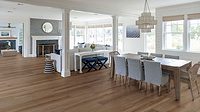Designing PureGrain Resilient Flooring

PureGrain Direct Digital Print DLVT by Engineered Floors features realistic wood visuals digitally printed in high definition, with fewer plank repeats than traditional LVT.
Photo: Engineered Floors.
Engineered Floors recently unveiled PureGrain Direct Digital Print DLVT, a new line of USA-made luxury vinyl tile created with high-resolution print technology on a high-density SPC core. Not only is PureGrain made in the USA, the LVT is also designed in Dalton, Georgia.
“Having the ability to make adjustments to our colors up to the minute, rather than having to communicate through channels and then waiting for the adjustment is a massive advantage,” said Emily Finkell, VP of residential product design, Engineered Floors.
The design team at Engineered Floors, which includes Finkell; Joe Young, VP of product development; and Amber Westmoreland Moore, color and design trend expert; spent over a year designing the wood-look SPC.

Joe Young, VP of product development.

Emily Finkell, VP of residential product design.

Amber Westmoreland Moore, color and design trend expert.
“The approach was consistent, and that is to approach the designs of our decors as if we are putting together a comprehensive collection of hardwood,” Finkell said.
While the heart of the hardwood market is white oak, the team wanted to incorporate the various cuts of hardwood, grades of hardwood, and treatments to create a rounded collection. They ended up with a mix that includes vintage premium white oak looks complete with the delicate, almost invisible, medullary rays, as well as rift, quarter-sawn, fumed and reactive visuals. To create these visuals, the team flipped the usual design process upside down.
“Over the years, when putting together a collection of LVT or resilient for other companies, it would always begin with going through the film books and sticky-noting the pages, then laying out large-format paper prints—usually on the floor of the hotel lobby in Shanghai—and marking up the areas of the visual to remove any and all unique features,” Finkell said.
Examples of what was removed include knots, splits, and figured grain patterns that could potentially look too noticeable when installed. The result over the course of time has been very plastic and ‘flat’ visuals on LVT that look nothing like real wood.
“Our own design process started with choosing the real wood, the actual planks, keeping the authentic features, knowing we will have 35 planks without a repeated board, digitizing these high-resolution images—300 times higher DPI than the usual 10 DPI in the industry—and applying colors that are specific to that type of wood cut, and visual,” Finkell said.



After traveling as far as Europe to source beautiful wood planks to scan, the team focused on creating color palettes are in step with the trends of the market—shifting away from gray, going both lighter and warmer.
“Our color work certainly follows that direction; however, we are designing for a national audience where certain pockets of consumers purchase more traditional red-based neutrals, or other areas with gray-browns,” Finkell said. “It’s essential that we get the full breadth of colors for every homeowner’s palette without having to create thousands of SKUs.”
That’s where high-resolution digital files comes into play. In authentic hardwood, the colors and contrast move naturally within each board, as well as across an entire space. To recreate this natural-looking visual, each color variation of PureGrain LVT incorporates complex pigments—multiple hues and shades that when digitally printed, convincingly look like natural wood.
“If there are more complex pigments, even if it’s very subtle touches of green, brown or gold, the complexity is what allows the colors to blend nicely into the interior,” Finkell said. “Overall, our color lines are going to provide consumers with some very exciting and easy-to-use colors for their homes.”
Looking for a reprint of this article?
From high-res PDFs to custom plaques, order your copy today!






